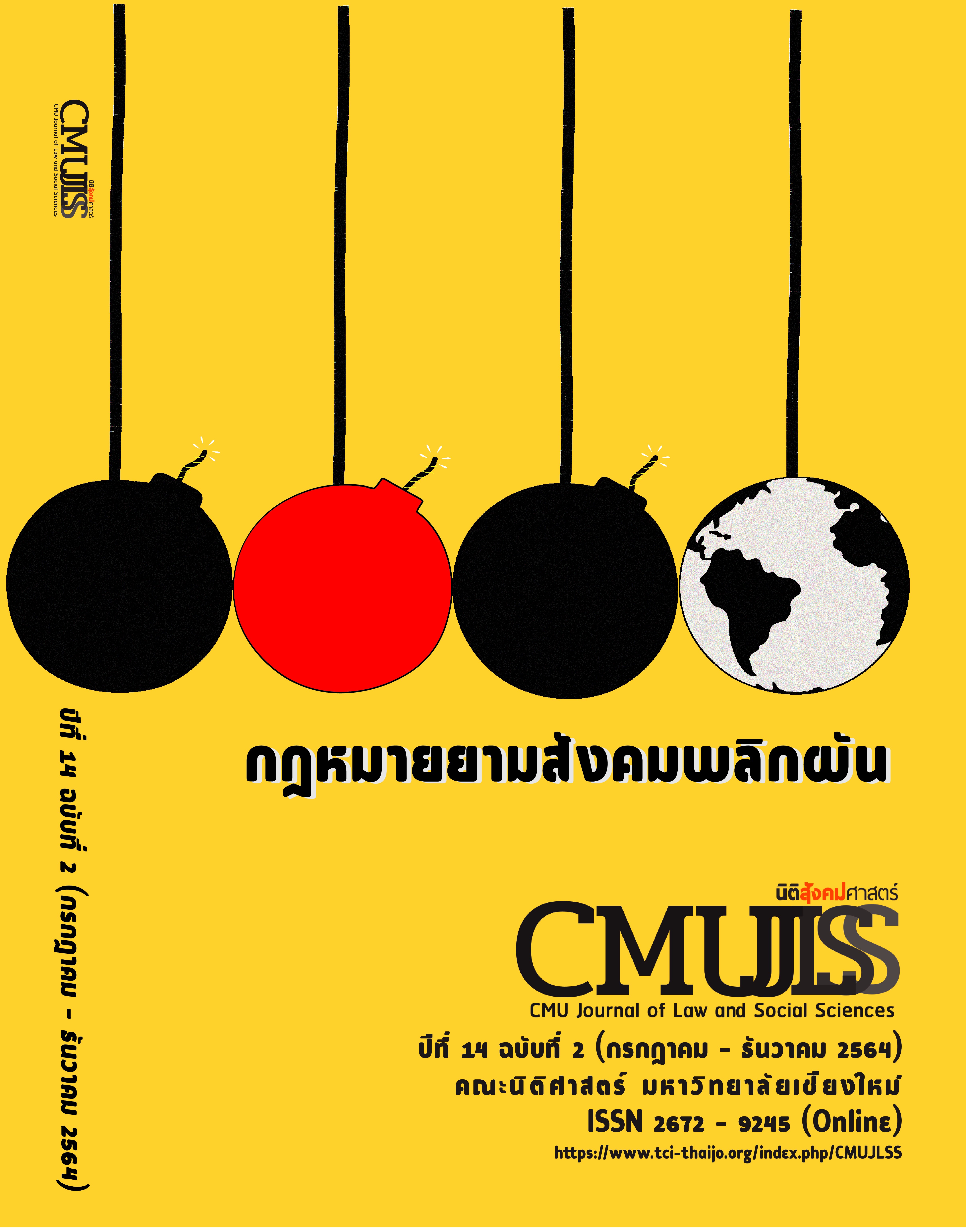บทบาทของตำรวจทางฟุตบอลในประเทศอังกฤษ
Main Article Content
บทคัดย่อ
ตำรวจทางฟุตบอลในประเทศอังกฤษมีส่วนสำคัญทั้งต่อสโมสรกีฬาฟุตบอลและชุมชนท้องถิ่น ในฐานะที่มีส่วนสำคัญในการช่วยลดอาชญากรรมเกี่ยวกับกีฬาฟุตบอลและเหตุชุลมุนวุ่นวาย พร้อมกับปรับปรุงความปลอดภัยในสนามกีฬาฟุตบอล รวมทั้งนำผู้กระทำผิดก่ออาชญากรรมทางการกีฬาไปรับโทษและใช้ดุลพินิจจับกุมผู้กระทำความผิดกับบังคับตามคำสั่งห้ามในกีฬาฟุตบอล บทความวิชาการชิ้นนี้มุ่งเป็นพิเศษที่จะอธิบายถึงบทบาทของตำรวจทางฟุตบอลในส่วนที่เกี่ยวข้องกับความผิดเกี่ยวกับกีฬาฟุตบอลและการบังคับตามคำสั่งห้ามในกีฬาฟุตบอล อีกทั้งบทความฉบับนี้ยังอธิบายและวิเคราะห์ถึงความร่วมมือที่มีประสิทธิภาพระหว่างผู้มีส่วนได้ส่วนเสียอื่น ๆ (เช่น ตำรวจฟุตบอลส่วนกลาง ภูมิภาคและท้องถิ่น) ที่มีส่วนช่วยป้องกันไม่ให้อาชญากรรมเกี่ยวกับกีฬาฟุตบอลและการก่อการร้ายเกิดขึ้นในประเทศอังกฤษและประเทศไทย
Article Details

อนุญาตภายใต้เงื่อนไข Creative Commons Attribution 4.0 International License.
O ความคิดเห็นใดๆ ที่ลงตีพิมพ์ใน CMU Journal of Law and Social Sciences เป็นของผู้เขียน (ความคิดเห็นใดๆ ของผู้เขียน กองบรรณาธิการ CMU Journal of Law and Social Sciences ไม่จำเป็นต้องเห็นด้วย)
O กองบรรณาธิการ CMU Journal of Law and Social Sciences ไม่สงวนสิทธิ์ในการคัดลอกแต่ให้อ้างอิงแหล่งที่มาด้วย
เอกสารอ้างอิง
Armstrong, Gary. Football hooligans: knowing the score. Oxford, UK: BERG, 1998.
Atkinson, Colin & Graham, William. “Just ‘students, old timers, and sammies’? Exploring the role of stewards and private matchday security in the plural policing of Scottish football.” International Journal of Police Science & Management 22, no.4 (2020).
British Police History. “UK Football Policing Unit.” Accessed January 20, 2021 http://british-police-history.uk/show_nav.cgi?force=football&tab=0&nav=alpha
Crown Prosecution Service. “Football Related Offences and Football Banning Orders.” Accessed January 20, 2021 https://www.cps.gov.uk/legal-guidance/football-related-offences-and-football-banning-orders
Drew, Bryan. “UK Football Policing Unit.” Accessed January 20, 2021 https://fsoa.org.uk/wp-content/uploads/2012/01/UKFPU-UK-NFIP-Role-Responsibilities-FSOA-Oct-11.pdf
Dunning, Eric, Murphy, Patrick & Williams, John. Football on trial: spectator violence and development in the football world. London, UK: Routledge, 1990.
Frosdick, Steve. & Marsh, Peter. Football hooliganism. Cullompton, UK: Willan Publishing, 1998.
Government Digital Service. “United Kingdom Football Policing Unit.” Accessed January 20, 2021 https://www.gov.uk/government/groups/united-kingdom-football-policing-unit-ukfpu
Home Office. Football-related arrests and banning order statistics, England and Wales, 2017-18 season. London, UK: Home Office, 2018.
Home Office. User guide to football related arrests and banning order statistics, England and Wales, 2016 to 2017 season. London, UK: Home Office, 2017.
James, Mark & Peason, Geoff. “Football banning orders: analysing their use in court.” Journal of Criminal Law 70, no.6 (2015).
Layton, Michael. Tracking the hooligans: the history of football violence on the UK rail network. Stroud, UK: Amberley Publishing, 2016.
Newson, Martha. “Football, fan violence, and identity fusion.” International Review for the Sociology of Sport 54, no.4 (2017).
Newson, Martha, Bortolini, Tiago., Buhrmester, Michael & Ricardo da Silva.“ Brazil’s football warriors: Social bonding and inter-group violence.” Evolution and Human Behavior 39, no.6 (2018).
Pearson, Geoff & James, Mark. “Public order and the rebalancing of football fans' rights: Legal problems with pre-emptive policing strategies and banning orders.” Public Law 3, July (2015).
Rogers, Danny., Woodhouse, John. & Politowski, Benjamin. Football hooliganism. London, UK: House of Commons Library, 2016.
Sentencing Council. “14. Football banning orders.” Accessed January 20, 2021 https://www.sentencingcouncil.org.uk/explanatory-material/magistrates-court/item/ancillary-orders/14-football-banning-orders/
Spaaij, Ramón. Understanding football hooliganism: a comparison of six Western European football clubs. Amsterdam, Netherlands: Vossiuspers UvA, 2006.
Strang, Lucy., Baker, Garret, Pollard, Jack & Hofman, Joanna. Violent and Antisocial Behaviours at Football Events and Factors Associated with these Behaviours: A rapid evidence assessment. Cambridge, UK: RAND Corporation, 2018.
Van Hiel, Alain, Hautman, Lobke., Cornelis, Ilse. & De Clercq, Babara. “Football hooliganism: Comparing self-awareness and social identity theory explanations.” Journal of Community & Applied Social Psychology 3, No.17 (2007).
Veuthey, Alexandra & Freeburn, Lloyd.“ The fight against hooliganism in England: insights for other jurisdictions?.” Melbourne Journal of International Law 16, no.1 (2015).

